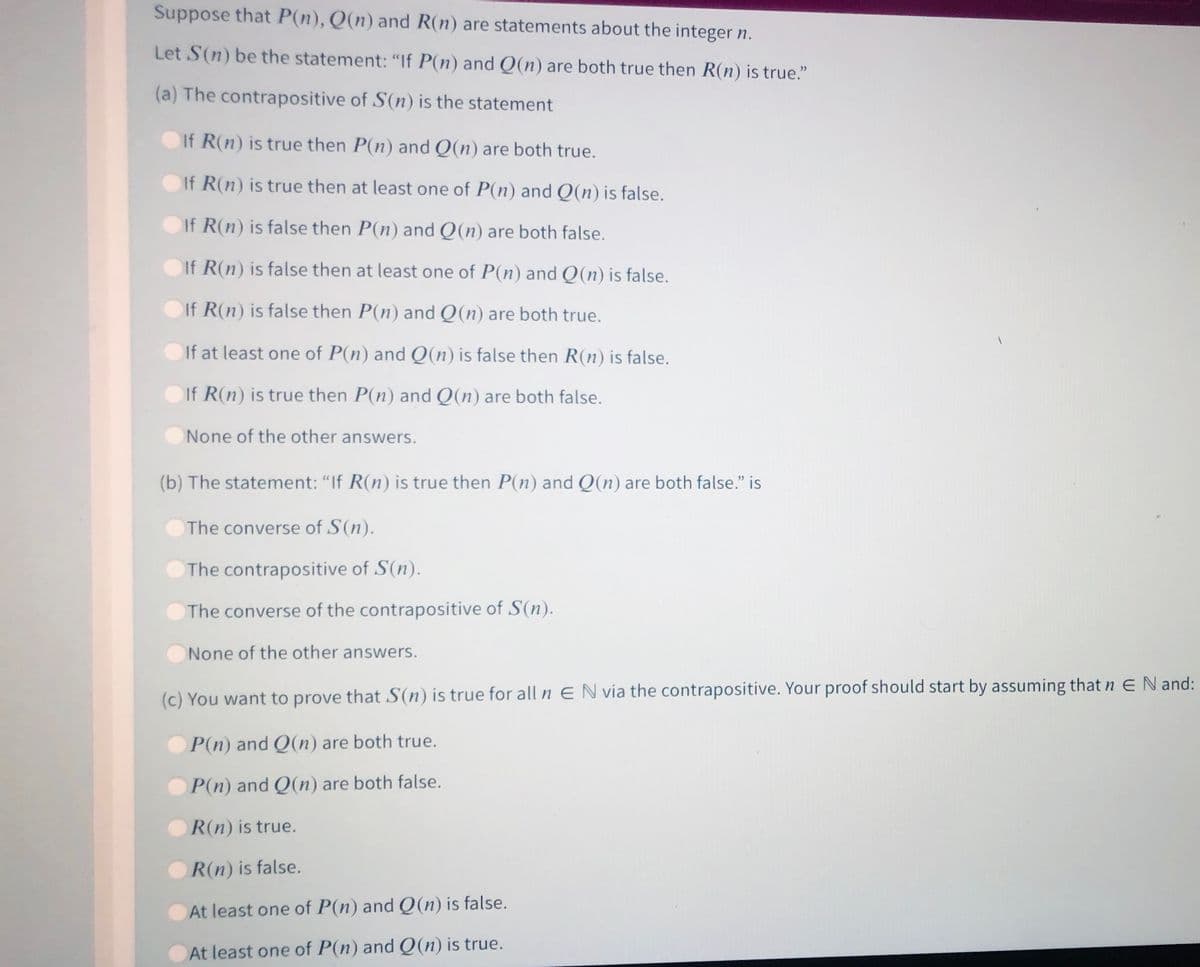Suppose that P(n), Q(n) and R(n) are statements about the integer n. Let S(n) be the statement: "If P(n) and Q(n) are both true then R(n) is true." (a) The contrapositive of S(n) is the statement If R(n) is true then P(n) and Q(n) are both true. If R(n) is true then at least one of P(n) and Q(n) is false. If R(n) is false then P(n) and Q(n) are both false. If R(n) is false then at least one of P(n) and Q(n) is false. If R(n) is false then P(n) and Q(n) are both true. If at least one of P(n) and Q(n) is false then R(n) is false. If R(n) is true then P(n) and Q(n) are both false. None of the other answers. (b) The statement: "If R(n) is true then P(n) and Q(n) are both false." is The converse of S(n). The contrapositive of S(n). The converse of the contrapositive of S(n). None of the other answers. (c) You want to prove that S(n) is true for all n EN via the contrapositive. Your proof should start by assuming that n E Nand P(n) and Q(n) are both true. P(n) and Q(n) are both false. R(n) is true. R(n) is false. At least one of P(n) and Q(n) is false. At least one of P(n) and Q(n) is true.
Suppose that P(n), Q(n) and R(n) are statements about the integer n. Let S(n) be the statement: "If P(n) and Q(n) are both true then R(n) is true." (a) The contrapositive of S(n) is the statement If R(n) is true then P(n) and Q(n) are both true. If R(n) is true then at least one of P(n) and Q(n) is false. If R(n) is false then P(n) and Q(n) are both false. If R(n) is false then at least one of P(n) and Q(n) is false. If R(n) is false then P(n) and Q(n) are both true. If at least one of P(n) and Q(n) is false then R(n) is false. If R(n) is true then P(n) and Q(n) are both false. None of the other answers. (b) The statement: "If R(n) is true then P(n) and Q(n) are both false." is The converse of S(n). The contrapositive of S(n). The converse of the contrapositive of S(n). None of the other answers. (c) You want to prove that S(n) is true for all n EN via the contrapositive. Your proof should start by assuming that n E Nand P(n) and Q(n) are both true. P(n) and Q(n) are both false. R(n) is true. R(n) is false. At least one of P(n) and Q(n) is false. At least one of P(n) and Q(n) is true.
Elements Of Modern Algebra
8th Edition
ISBN:9781285463230
Author:Gilbert, Linda, Jimmie
Publisher:Gilbert, Linda, Jimmie
Chapter8: Polynomials
Section8.4: Zeros Of A Polynomial
Problem 18E: Show that the converse of Eisenstein’s Irreducibility Criterion is not true by finding an...
Related questions
Topic Video
Question

Transcribed Image Text:Suppose that P(n), Q(n) and R(n) are statements about the integer n.
Let S(n) be the statement: "If P(n) and Q(n) are both true then R(n) is true."
(a) The contrapositive of S(n) is the statement
If R(n) is true then P(n) and Q(n) are both true.
If R(n) is true then at least one of P(n) and Q(n) is false.
If R(n) is false then P(n) and Q(n) are both false.
If R(n) is false then at least one of P(n) and Q(n) is false.
If R(n) is false then P(n) and Q(n) are both true.
If at least one of P(n) and Q(n) is false then R(n) is false.
If R(n) is true then P(n) and Q(n) are both false.
None of the other answers.
(b) The statement: "If R(n) is true then P(n) and Q(n) are both false." is
The converse of S(n).
The contrapositive of S(n).
The converse of the contrapositive of S(n).
None of the other answers.
(c) You want to prove that S(n) is true for all n E N via the contrapositive. Your proof should start by assuming that n E N and:
P(n) and Q(n) are both true.
P(n) and Q(n) are both false.
R(n) is true.
R(n) is false.
At least one of P(n) and Q(n) is false.
At least one of P(n) and Q(n) is true.
Expert Solution
This question has been solved!
Explore an expertly crafted, step-by-step solution for a thorough understanding of key concepts.
Step by step
Solved in 2 steps

Knowledge Booster
Learn more about
Need a deep-dive on the concept behind this application? Look no further. Learn more about this topic, calculus and related others by exploring similar questions and additional content below.Recommended textbooks for you

Elements Of Modern Algebra
Algebra
ISBN:
9781285463230
Author:
Gilbert, Linda, Jimmie
Publisher:
Cengage Learning,

Algebra & Trigonometry with Analytic Geometry
Algebra
ISBN:
9781133382119
Author:
Swokowski
Publisher:
Cengage

Elements Of Modern Algebra
Algebra
ISBN:
9781285463230
Author:
Gilbert, Linda, Jimmie
Publisher:
Cengage Learning,

Algebra & Trigonometry with Analytic Geometry
Algebra
ISBN:
9781133382119
Author:
Swokowski
Publisher:
Cengage